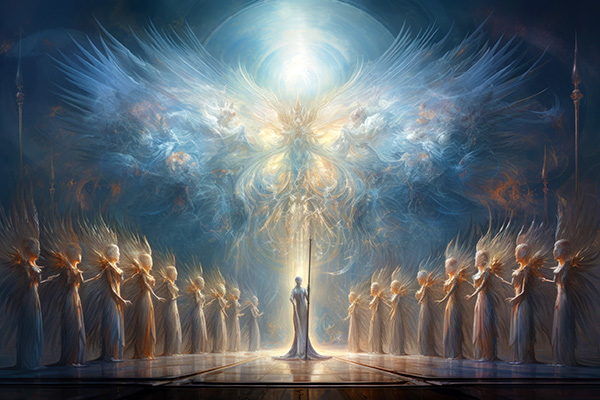Is it a Message from the Spirit or a Superstition Driven by Fear?
 My father and his broader family held many superstitions. For example, they avoided purchasing a car on Fridays, would not discuss new shoes in the morning, and never exited a house from the back door if they had entered through the front. I could elaborate further.
My father and his broader family held many superstitions. For example, they avoided purchasing a car on Fridays, would not discuss new shoes in the morning, and never exited a house from the back door if they had entered through the front. I could elaborate further.
These traditional beliefs were deeply embedded in their lifestyle and handed down like precious heirlooms of caution and despair. Yet, I never observed any tangible proof that these beliefs held truth — until I encountered a peculiar situation that initially seemed like a bad omen.
In 1983, I had been aspiring to secure a position with the local council for a considerable time. Then, unexpectedly, I received a contract from them! I was elated. The pay was excellent, and I felt incredibly lucky, especially given the high unemployment rate and economic downturn in the UK.
That weekend, I decided to treat myself by purchasing a large bottle of costly wine. However, as I exited the liquor store, the bottle slipped from my grasp and shattered on the pavement.
“Oh no,” I remarked to my late sister. “I hope this doesn’t signal that my dreams are about to break apart like this! Could this be a cosmic sign of a bad outcome for my new job?”
My beloved sister, always the rational one, reassured me that it was merely an accident and not an ill omen. Nevertheless, coming from a superstitious background, I took that apprehension and carried it with me into my new position.
Initially, things progressed quite positively. But soon, I discovered that my colleagues were unkind and cruel, the secretary was quite a bully, my boyfriend ended our relationship, and my father, showcasing his narcissistic traits, repeatedly questioned my ability to “fulfill the job.”
Ultimately, I was let go and found myself unemployed for almost a year.
When you shift your perspective, the things you perceive begin to transform ~ Wayne Dyer
So, was the shattering bottle a premonition of the outcome that awaited me, or did my inherited superstitious fears undermine my confidence and shape the sequence of events? Over the years, I have come to realize that it was not a foreboding sign from the universe, but rather a matter of personal interpretation and belief. The real issue was not the broken wine bottle; it lay in my interpretation of its significance.
The Challenges of Superstition
Nowadays, I recognize that superstitious fears do not equate to genuine signs from Spirit, Source, God, or the Divine. Superstition arises from an attempt to exert control over the uncontrollable by attributing causes and effects where none genuinely exist. Not every peculiar or unexpected occurrence signifies a bad omen or a harbinger of disaster. At times, our experiences are simply part of the natural course of living in a physical world. The incident with the bottle was far more about my distraction and overexcitement—and the ever-present force of gravity!
The real dilemma with superstition lies in its ability to instill negative beliefs within us. Whether we’re steering clear of ladders, fearing shattered mirrors, or interpreting spilled wine as an indication of future disaster, these unfounded beliefs can become spiritually potent, if we allow them to.
Energy itself holds no inherent morality — it simply responds to what we focus on and resonate with. The Law of Attraction is neutral. Thus, subscribing to a superstition can inadvertently manifest the very outcomes we dread, not due to any true power of the superstition, but because we align our vibrational frequency with that belief.
In my situation, I chose to regard the shattered wine bottle as a bad sign. The universe was neither punishing me nor issuing a warning. It was my belief system that crafted my reality. Looking back, I can see that my self-esteem and confidence were already quite delicate. Perhaps the broken bottle didn’t foretell the future but rather echoed my existing inner doubts.
Some unique occurrences and experiences, however, do hold genuine spiritual significance. These represent the sacred communications from spirit and the divine, gently urging us forward. When approached with openness and trust, such signs illuminate our path rather than obscure it.
But how can we tell a genuine sign from spirit, the universe, or our higher selves, apart from mere accidents—or worse, fear-based superstitions? The answer is straightforward: true signs foster faith, not fear. They embody uplifting, hopeful, and reassuring energy — never ominous or distressing.
Fear is the primary source of superstition, and one of the main sources of cruelty. Conquering fear is the beginning of wisdom in the pursuit of truth as well as in the quest for a meaningful life ~ Bertrand Russell
Signs in Spiritual Frameworks
In numerous spiritual traditions, signs are seen as divine messages that confirm our path or guide us toward a higher purpose. In Christianity, for instance, signs manifest as extraordinary events and wonders within the Bible representing divine intervention, like the rainbow in Genesis, symbolizing God’s covenant with Noah. Likewise, the Star of Bethlehem led the Magi to Jesus’ birthplace, embodying hope, salvation, and the fulfillment of prophecy.
In Hinduism, dreams and nature are revered as sacred avenues through which deities convey messages. For instance, dreaming of a white elephant is considered extremely auspicious. Additionally, Native American traditions assert that animals and natural signs serve as spirit messengers, interpreting each appearance as significant guidance.
In shamanic practices, encountering a specific animal totem—be it in dreams, trance states, or real life—signals guidance, transformation, or lessons to learn. Some views also regard totems as indicators of personal growth, appearing at different life stages to reflect one’s evolving spiritual journey.
In Kabbalah, the mystical dimension of Jewish spirituality, interpreting signs is a deeply rooted practice. Kabbalists believe that every event, from a chance meeting to the timing of occurrences, possesses spiritual significance. The belief in hashgacha pratit, or divine providence, suggests that the universe is perpetually communicating with us through signs, offering guidance for our soul’s tikkun, or spiritual correction.
Upon receiving divine guidance, we begin to transform ourselves mentally, physically, and spiritually. No longer are we lost in the world; we can finally see ~ Amaka Imani Nkosazana
Identifying Authentic Signs From Spirit
Recognizing authentic signs from spirit is vital — it assists us in navigating our spiritual journey with enhanced clarity, hope, and confidence. Signs provide guidance, reassurance, or even gentle warnings, influencing our decisions, deepening our faith, and directing us toward our highest good.
Nonetheless, discernment remains crucial. Not every coincidence carries a sacred message, and false signs can be misleading. This is where spiritual wisdom, prayer, and alignment with sacred teachings become instrumental—they aid us in differentiating between divine communication and mere coincidence.
Signs serve as invitations, not directives. They pertain to free will, not destiny or misfortune. They present us with an opportunity to engage more meaningfully with life, spirit, and the divine. Our interpretations mirror our internal state, our beliefs, and our current spiritual path. A true sign encourages us to reflect, reevaluate, and build deeper trust in ourselves and in the paths we tread. It does not impose control; it offers support. It demands faith, not trepidation.
I recall being about nine years old, participating in a Cinderella pantomime with my classmates. No one could agree on who would portray Cinderella. Then one day, as I walked home from school, I lost my shoe — and my friend Christine discovered it. Was it a cosmic message? Perhaps. Or maybe just a lovely coincidence. But to me, at that moment, it felt like a sign. That sense of intuitive clarity possessed a semblance of magic. Perhaps this is how Spirit begins to guide us, even as children, to follow our inner wisdom, to notice subtle cues and synchronicities—and to persist in pursuing our aspirations.
So, what’s the real takeaway here? We must be mindful of the authority we give to events and experiences. We can let fear-driven superstitions and limiting beliefs mold our realities, or we can approach life with curiosity and an open heart—prepared to unearth meaning without being restricted by it.
As for superstitions, we need to recognize them for what they truly are: cultural artifacts and psychological triggers that can trap our thoughts. Instead of allowing unfounded beliefs to dictate our experiences, we can employ awareness to undermine their influence and choose our focus deliberately.
Let us stay receptive to the signs from the universe and gentle nudges from spirit while remaining aware of the narratives we create for ourselves. Sometimes, a shattered bottle is simply just that — a shattered bottle. And occasionally, losing a shoe signifies that it’s your time to shine!
|
Lucinda is a skilled Intuitive and Empath, residing in a picturesque village in North Yorkshire, England. She possesses the unique ability to empathize with a client’s personal struggles and has endured numerous challenges, which has only made her more resilient! It is both her vocation and her joy to aid those in need. Whenever she seeks guidance herself, her Guides are always present to assist in her growth and offer clear insights for her clients. Prediction has always been a reliable tool she could count on to accurately foresee events; however, Lucinda also utilizes her expertise in Dream Interpretation, Numerology, Angel Cards, the Law of Attraction, and Life Coaching to deliver comprehensive solutions to any issue. A member of AMORC and Beyond Freedom Evolution, she provides inspiration, education, and personal support for spiritual growth. If you seek answers or wish to manifest your desires, you can find Lucinda at PsychicAccess.com. |
Have you ever encountered an unusual event that made you ponder whether it was a sign from the universe or merely a fear-based superstition? Many people wrestle with this question, attempting to decipher the significance behind specific events or sensations.
A common example is spotting a black cat crossing your path. In various cultures, this is viewed as an omen of misfortune. Conversely, others believe black cats symbolize protection and prosperity. So, which view is correct? Is it a message from spirit or a fear-driven superstition?
Ultimately, the answer hinges on your personal beliefs and mindset. If you’re open to the idea of signs and messages from the universe, you might interpret the sighting of a black cat as an encouragement to trust your intuition and instincts. Alternatively, if you lean towards skepticism and hold steadfast to superstitions, you might view it as a cautionary sign to be wary of potential threats.
It’s crucial to keep in mind that divine signs are often subtle and can easily be misconstrued. Trusting your intuition and inner guidance is essential when attempting to decipher the meanings behind certain occurrences or feelings. If something feels amiss or unsettling, it might be a signal to pause and reevaluate the situation.
Conversely, fear-based superstitions typically arise from cultural beliefs and traditions that have been handed down through generations. While these superstitions may bear some truth or significance for certain individuals, it’s crucial not to allow them to dictate your actions or decisions.
Ultimately, whether a situation represents a message from spirit or a fear-based superstition, approaching these occurrences with an open mind and a spirit of curiosity is essential. Tune into your intuition and inner guidance, and trust that you possess the wisdom and insight needed to navigate any challenges or uncertainties that arise. Continue reading

















